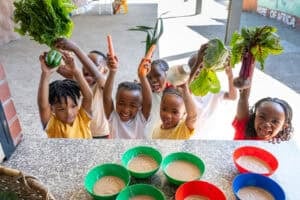There's belief that tech 'can be a game-changer' when it comes to tackling hunger.

As with all generation gaps, the older ones tend to accuse the younger generations of being shallow, idle and uncaring about the “big picture” issues.
That accusation has been levelled against members of Generation Z, those born between 1997 and 2012.
Yet, in reality, global surveys have showed this group of young people to be some of the most concerned about the problems confronting humanity… and how to harness technology to deal with them.
Ways to tackle child hunger
And, ahead of World Food Day last week, 60 of South Africa’s tech-savvy Gen Z innovators spent a week coming up with digital-driven ideas to tackle one of the country’s gravest social issues, child hunger.
During The Biggest Hunger Hack, a challenge hosted by KFC Africa, they used artificial intelligence (AI), blockchain, data visualisation and community-driven platforms to deliver real assistance schemes to combat hunger.
The overall winning team, CtrlAlt-Del-Hunger, turned South Africa’s food waste crisis into a social impact opportunity.
ALSO READ: Millions hungry as malnutrition tightens its grip on SA
Their Misfits Mzansi app rescues “ugly” fruit and veg that would normally be trashed on farms and delivers it to food-insecure families.
The platform also hosts short-form cooking challenges, edutainment content and ad-driven donations so users literally feed families by engaging with content.
“You become a philanthropist just by watching a video,” said the team.
Hopecoins
The Hack4Hope team’s solution was a WhatsApp chatbot that allows customers to scan a QR code from their KFC till slip toinstantly donate to the company’s AddHope campaign.
Add Hope, powered by millions of R2 donations from KFC customers, already helps more than 3 300 feeding centres across the country, reaching over 154 000 children last year.
In its 15-year existence, AddHope has ploughed R1 billion (R600 million from customers and R400 million from KFC itself) into vitally needed feeding schemes.
READ MORE: Over 1 400 children in Gauteng suffered from severe acute malnutrition in 2024–25
Hack4Hope’s chat bot is built on blockchain and provides proof of every R2’s journey, from donor to meal served, creating full transparency and reinforcing trust.
The platform’s “hopecoins” reward repeat donors and gamify giving.
The Streetwise team scripters built a social-media-first donation ecosystem.
Their concept includes a real-time donor dashboard, donation hotspot map and a KFC loyalty rewards integration, where good deeds unlock free meals.
Some of those who took part in the hackathon shared their thoughts about the issue of hunger.
‘Hunger steals potential’
Lunga Mashaba said: “No child should ever have to face the pain of an empty plate. Hunger steals potential – it robs children of focus in school, of joy in play and of hope for the future.”
Rorisang Mokobane said solving child hunger is “more than a cause – it’s a moral responsibility. When we feed a child, we’re not just giving food; we’re feeding possibility.
Shepherd K Thobejane said he believes tech “can be a game-changer” when it comes to tackling hunger.
“From mobile apps. to track food distribution, to data analytics for predicting hunger hotspots, there are so many ways to tackle this issue. It’s about finding the right solutions and scaling them up,” he said.
As a representative of Generation Z, he added he feels that “as young people, we’re not afraid to challenge the status quo and think outside the box”.
“We’ve grown up with the internet and social media, so we’re well-equipped to mobilise, raise awareness, and push for change,” he said.
Andra Nel, KFC Africa’s head of brand purpose and environmental, social and governance, said the biggest hunger hack had shown that Gen Z understands the problems of hunger “because many have lived it and they understand technology because they were born into it.”
NOW READ: Food Security Index: slight improvement, but people still going hungry






